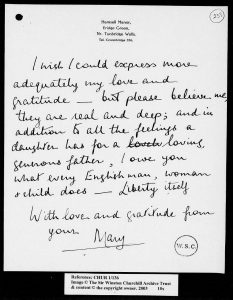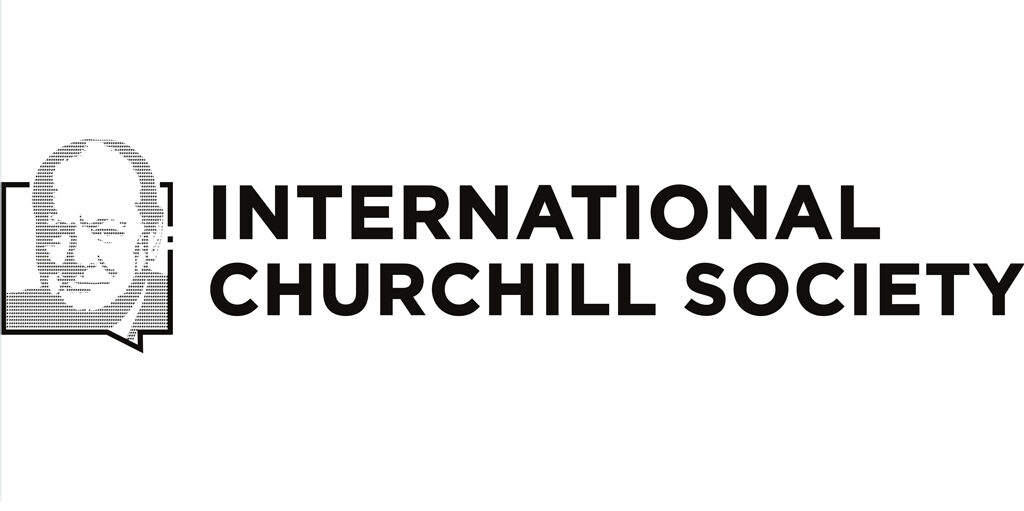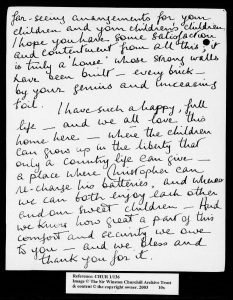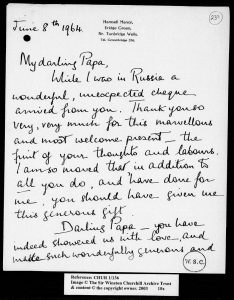
Finest Hour 164
Remembrances – Her Ladyship: A Bookman’s Memoir

Winston Churchill, Parliament Square, London © Sue Lowry & Magellan PR
February 10, 2015
Finest Hour 164, Special Edition, September 2014
Page 18
By Barry Singer
I first met Lady Soames in the Chartwell Kitchen Garden, miraculously, and on my very first visit. It was the summer of 1985, barely a year after the April 1984 opening of a tiny, Churchill-centric bookshop in New York City that I’d named for Churchill’s home in the Kent countryside—though I’d not yet even seen Chartwell myself. A summer book buying trip to England gave me the chance.
Circumnavigating the verdant Kentish landscape and finally entering the house Churchill had so loved was poignant and electrifying. Following a giddy house tour, filled with an enveloping sense of his presence, I found myself drawn to the Kitchen Garden, where I sat quietly on a bench gazing out at the vista.

2025 International Churchill Conference
In the distance, a door opened and a solitary female figure emerged onto Chartwell’s manicured lawn terrace. I observed her without thought, as she made her way toward me. It is a rather long walk from the main house to Chartwell’s brick-walled gardens. Until she entered— through a gateway in the brickwork that her father the bricklayer had once helped to construct—I really hadn’t a clue who this red-coated stroller might be. Then I recognized her. It was Mary Soames.
We acknowledged one another; after all, we were alone together in a garden. I introduced myself and she, in turn, told me most offhandedly who she was, adding that she often stopped by to look in on her childhood home and visit with “Mrs. Hamblin”—Grace Hamblin—who had served both Winston and Clementine Churchill as private secretary, and who now watched over Chartwell as its first administrator.
Inevitably, I asked Lady Soames if I could take her picture. She smiled, yes. Inevitably, I also told her about Chartwell Booksellers. She was immediately full of questions: Could a bookstore really survive on her father’s books alone? Whatever had given me the idea? Where exactly was this extraordinary place?
Over the ensuing years, all of my re-encounters with Lady Soames seem, in my recollection, variations on our initial meeting. She always appeared unexpectedly and at a distance, visible through my store window, marching toward the shop alone and unannounced. Always she exuded the vivacity that I like to think she inherited from her father. Ever gracious, ever curious and utterly without pretense, she signed her own books at a gallop, thumbed through anything that was new on the subject of Winston Churchill, and departed as she had come: alone.
Years later, when Lady Soames could no longer travel overseas, I came to possess a volume with a deeply personal connection to her. It was a First American edition of The Gathering Storm, the first volume in Churchill’s six-volume memoir of the Second World War, inscribed in ink on the front free endpaper: ”To Mary and Christopher from Papa, 1948.” This was Churchill’s inscription to his recently wed daughter; she had married Christopher Soames on 11 February 1947. There were, moreover, extensive notes in Lady Soames’s hand, penciled across the rear endpapers.
The moment the book arrived, I emailed Her Ladyship. Was this indeed hers? Had the book nefari- ously gone missing somehow from her library?
At first she was mystified. In her library, she informed me, there was The Gathering Storm inscribed to her and Christopher by her father—but dated 1954. The mystification lifted somewhat when I mentioned one further detail. My copy had originally been acquired, I’d been told, together with another written by her father that was inscribed: ”Nana, love Christopher and Mary.”
“‘Nana’ was my mother’s first cousin,” wrote back Lady Soames, “Maryott Whyte, who looked after me very soon after my birth until the beginning of the war and who generally invigilated Chartwell in my parents’ absence.” I confess I had to look up that word, “invigilated.” Turns out it is something of a Britishism, meaning “to supervise candidates during an examination.”
Lady Soames would later write at affectionate length in A Daughter’s Tale about Maryott “Moppet” Whyte’s powerful, positive influence on her childhood, and her special devotion to “Nana.” I wonder if she did not at some point give that first inscribed copy of The Gathering Storm to Maryott Whyte. Sir Winston then would have replaced the book in 1954, the year that the final volume of his war memoirs was published.
I offered to return the book to Lady Soames.
“I would be very sorry to see you at a loss over it,” she replied, with characteristic magnanimity. “I therefore have no objection to your selling the book.”
I thanked her then, and I thank her now, one final time. She was an exquisite exponent of all that her father represented. She also was quite a lady.
Mr. Singer is proprietor of Chartwell Booksellers in New York City and the author of Churchill Style (reviewed in Finest Hour 155). This article was first published in the Huffington Post for June 12th.
Subscribe
WANT MORE?
Get the Churchill Bulletin delivered to your inbox once a month.





